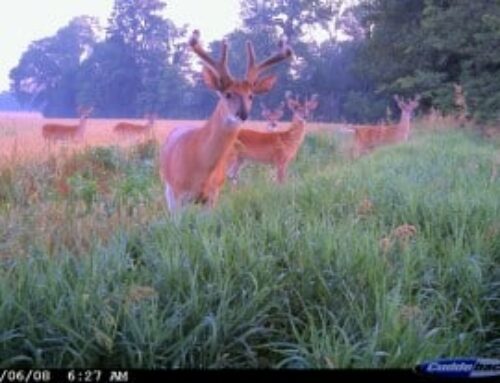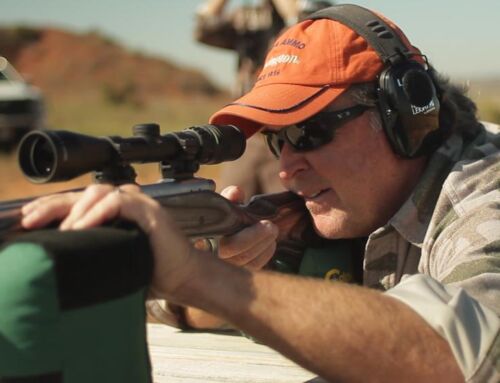Some really good hunters I know don’t hunt their best spots until around Halloween, and then they hunt them hard for the next two weeks. Their strategy is sound: put no pressure on bucks until they start rutting and moving more in daylight hours.
Good in theory, yes, but I don’t believe that approach is practical for most of us. You’re busy…you bowhunt when you can. If that happens to be in October, great. The woods are beautiful, the weather is nice and there are fewer people in the timber than there will be come November. There are opportunities to get your buck, and here are some things to keep in mind.
Food in the Woods
Grant Woods, one of the premier whitetail scientists in America and a seasoned archer who hunts as many days as he can in October, says to key on what the deer are eating right now.
“If you’re not seeing deer in October, you aren’t hunting in the right places,” he says. “Deer change their behavior as they go from summer to fall patterns. Our telemetry studies don’t show any let up in feeding activity during the so-called ‘lull’ in October. You’ve just got to find them.”
According to Grant, the main reason deer seemingly disappear during early October is a change in their diets, and subsequently a change in their movements. In summer and throughout September they fed often in crop fields, where they were visible. “But now many deer feed on browse and mast inside the woods, and they aren’t as easily seen,” he says. “Mast is a very strong attractant, and bucks will abandon their summer forage patterns when acorns start dropping. Find the mast and you’ll find some bucks.”
Most hunters know to look for acorns. But an overlooked strategy is not to focus enough on thickets in the woods, and the cover and browse they provide for deer. As they mender through the October woods between bedding covers and mast trees and fields, bucks veer here and there to walk through thickets, where they linger and nibble leaves, buds and stems. Look for trails with recent tracks leading to and from thickets; fresh rubs and scrapes nearby make the setup even better. Play the prevailing wind, and hang a stand for an ambush.
Find and Hunt Rub Lanes
A study in west-central Tennessee found that two types of terrains—“valleys” and “secondary points”—clustered many more buck rubs than the surrounding topographies. You know what valleys are. The researchers found that swales and draws with brushy ground cover (big bucks love that) and mast trees with fresh acorns (all deer love those) had twice as many or more rubs than mature bottoms with large, open hardwoods.
Researchers describe “secondary points” as small fingers of ground that drop off the sides of main ridges and slope down toward the valley floors. Bucks use the points as ramps for easy and hidden access from lowlands to hills and ridges, and they naturally blaze rubs as they come and go.
Scout for points, fingers and tips of land that slope down off a big ridge and into hollows or creek bottoms. The thicker the cover in and around the secondary points the better. Generally you’ll want to hang a bow stand parallel to or slightly above a point where your visibility and wind are best, especially for morning hunts when the thermals rise.
October Weather
There are few things I love as much as sitting in a tree stand on an Indian Summer afternoon, enjoying life as a hunter. A good buck could wander by, but if not that is okay. As I enjoy the dry, warm air on my face, I check the weather apps on my phone and look forward to the coming cooler days when I know the bucks will move better.
The first two or three days after a cold front blows through in October and drops the temperature from, say, 65 degrees to 35, are prime time to hunt. Bucks that were slow and sluggish a few weeks earlier get a spring in their step and move a little more. You’ll usually have to deal with moderate winds on the backside of a front, but you can live with it because the high-pressure that builds in for the next few days will put some mature bucks on their feet, increasing the chances that one will wander beneath your stand. Head to your best sets near acorns, thickets or crops.
Find the Perfect Tree
One October afternoon several years ago, Ontario bowhunter Shane Good shot the buck of his dreams, a 171-inch giant. Two years later, on October 27, Shane ran his climber up the same tree and watched incredulously as another buck—bigger than last year’s—rolled onto the scene. His arrow was true; the main-frame 10-pointer scored 176!
I emailed Shane and told him it would be some accomplishment to shoot a third monster from the same tree in a span of just a few short years. That October 28, he sent me this note:
Mike, wanted to show you the buck I arrowed earlier today. You said it would be awesome to shoot three 170s from the same tree. I had to settle for a 162 this year, ha ha!
Look deeper inside Shane’s incredible achievement and you’ll find three lessons that go to our theme here:
One, Shane’s stand is set on the edge of a linear thicket on a ridge. He watched all three of the big bucks he shot (as well as other bucks and does) come from a distance and veer into the thicket to stage and browse the greenery. Thicket stands produce.
Two, all things considered, the last week of October is the best week to plan your bowhunting vacation any year. The weather is starting to cool down, and the bucks are scraping and moving. The full moon this week this season will the hunting better yet.
Third, find a hot tree that produces and hunt it year after year around the same time each season. The three giants that Shane shot were not there by happenstance. They funneled by that tree while moving between feed and bed, and Shane was in just the right spot. You probably won’t shoot three monsters from your perfect tree, but you’ll get a good buck every year or so. That’s pretty darn good for October.






